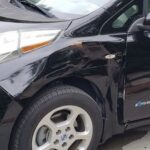Driving with a scratched windshield is more than just annoying. Those distracting lines and marks can significantly compromise your visibility, turning a simple drive into a potential hazard for you, your passengers, and others on the road. Instead of straining your eyes or looking around the damage, you might be relieved to know that fixing minor windshield scratches yourself is often possible, saving you the cost of a full replacement. This guide will walk you through effective DIY methods to restore clarity to your car’s windshield.
Understanding Minor Windshield Scratches and DIY Solutions
When it comes to windshield scratches, identifying the severity is the first step. Minor scratches are typically surface-level imperfections that are easily visible but don’t catch your fingernail when you run it across them. These are the types of scratches that can often be addressed with simple DIY solutions.
For these less severe scratches, a few common household and readily available products can make a noticeable difference. Let’s explore some of the most effective methods.
Acrylic Scratch Remover: The Easiest Solution for Light Scratches
One of the simplest approaches to fixing minor windshield scratches is using an acrylic scratch remover. This specialized liquid is designed to fill in the scratch, effectively making it disappear.
Applying acrylic scratch remover is straightforward:
- Clean the Windshield: Thoroughly clean the scratched area of your windshield and let it dry completely. This ensures no dirt or debris interferes with the scratch remover.
- Apply the Remover: Apply a small amount of acrylic scratch remover directly onto the scratch.
- Buff Gently: Using a soft microfiber cloth, gently buff the scratch remover into the scratch using circular motions.
- Let it Dry: Allow the scratch remover to dry according to the product instructions. As it dries, it will harden and fill the scratch, becoming transparent and significantly reducing the scratch’s visibility.
Acrylic scratch removers are readily available at most auto parts stores and are an excellent first attempt for superficial windshield blemishes.
Cerium Oxide: For Slightly Deeper Windshield Imperfections
For scratches that are a bit more noticeable, such as light wiper scratches or slightly deeper abrasions, cerium oxide offers a more robust solution. Often found in auto glass repair kits, cerium oxide is a compound that, when buffed into the glass, polishes and smooths out minor imperfections.
Here’s how to use cerium oxide to repair windshield scratches:
- Prepare a Cerium Oxide Paste: Mix cerium oxide powder with water to create a paste with a glue-like consistency. Follow the instructions on your cerium oxide kit for the correct ratio.
- Apply the Paste: Apply the cerium oxide paste liberally to the scratched area of your windshield.
- Use a Polishing Wheel: Attach a polishing wheel to a standard drill. These wheels are usually made of dense wool felt and are designed for glass polishing.
- Buff the Scratch: Gently buff the scratched area with the polishing wheel in a circular motion. Keep the paste moist by spraying water occasionally. Continue buffing until the scratch is visibly reduced or disappears. This process may take some time depending on the scratch depth.
- Clean the Area: Once you’re satisfied with the results, clean the area with water and a clean cloth to remove any remaining cerium oxide residue.
Cerium oxide is a more involved method but can effectively tackle slightly deeper minor scratches, restoring a clearer view.
Baking Soda Toothpaste: A DIY Home Remedy for Very Light Scratches
For extremely light, surface-level scratches, you might be surprised to learn that white toothpaste with baking soda can act as a mild abrasive to buff them out. This is a budget-friendly home remedy for the most superficial windshield marks.
To use toothpaste for scratch removal:
- Apply Toothpaste: Place a small dot of white toothpaste (ensure it contains baking soda) onto a soft cloth.
- Rub onto Scratch: Gently rub the toothpaste onto the scratched area using circular motions.
- Repeat if Necessary: Repeat the application and rubbing process as needed.
- Wipe Clean: After a few minutes of rubbing, wipe away the excess toothpaste with a damp cloth to check if the scratch has improved.
Toothpaste is best suited for hairline scratches and may require multiple applications to see noticeable results.
When Professional Windshield Repair Becomes Necessary
While DIY methods can handle minor scratches effectively, it’s crucial to recognize when a scratch is beyond a simple fix. Deep, large, or strategically placed scratches, especially those directly in your line of sight, can compromise the structural integrity of your windshield and pose a significant safety risk.
If you find that DIY methods are ineffective, or if the scratch is:
- Deep and Catches Your Nail: This indicates a more significant gouge in the glass.
- Obstructs Driver Vision: Scratches directly in your line of sight are critical safety concerns.
- Large or Spreading: Extensive or worsening scratches require professional attention.
In these situations, consulting with auto glass professionals is the safest course of action. They can assess the damage and determine whether a repair or a full windshield replacement is necessary. Prioritizing clear vision is paramount for safe driving, and professional services ensure your windshield is in optimal condition.
Conclusion:
Maintaining a clear windshield is essential for driving safety. For minor scratches, DIY repair methods using acrylic scratch remover, cerium oxide, or even baking soda toothpaste can be effective solutions. However, for deeper or vision-obstructing scratches, it’s always best to seek professional auto glass services to ensure your safety and the structural integrity of your vehicle. Addressing windshield scratches promptly not only improves your driving experience but also contributes to safer roads for everyone.

